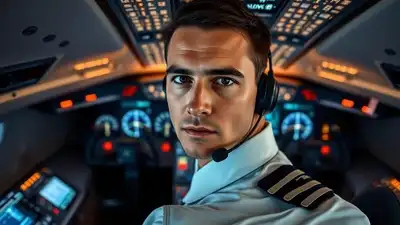ARTICLE AD BOX

Pilot Focused in Modern Cockpit (AI Image)
When most students dream of becoming a pilot, they imagine soaring through skies, wearing crisp uniforms, and commanding the cockpit like a movie hero. But as the recent Air India crash has grimly reminded us, aviation is less about glamour and more about grit.
In the tightly enclosed space of a cockpit, every switch, every second—and every silence—can mean life or death.The preliminary findings from the Air India AI‑171 crash show something chilling: both engines were cut off manually, seconds after takeoff, and the cockpit voice recorder captured confusion, not command. One pilot asked, “Why did you cut off the fuel supply?” The other replied, “I didn’t.” No one took responsibility.
Both engines shut down. 260 lives were lost.The disaster has forced the industry to revisit one unsettling truth: Flying is not just about skills; it's about psychology, procedures, and high-pressure thinking. Here's what every pilot trainee is taught—lessons that the world rarely sees, but actually shape and surprise every aspiring pilot.
Flying the plane is just 10% of the job
What students believe: You’re in command, flying hands-on all the time.
What they learn: The autopilot is your co-pilot—and sometimes, your boss.From the very first simulator sessions, students realise flying is less about “stick and rudder” and more about systems management. Modern aircraft are designed to be flown through layers of automation. The pilot’s true role is to monitor, anticipate, and intervene intelligently—not to constantly maneuver the aircraft like a video game.
- Pre-flight planning, weather checks, alternate routing, fuel load optimisation, and traffic management are just as critical as actual take-offs and landings.
- A large chunk of training involves understanding avionics, FMCs (Flight Management Computers), and multi-layered system checks.
Reality check: A pilot isn’t paid to fly. They’re paid to step in when systems fail.
The cockpit is designed for the brain, not the hands
What students believe: Flying is a physical task.What they learn: It’s a cognitive marathon.Pilots are trained in situational awareness—which means constantly knowing what’s happening, what’s about to happen, and what might go wrong next. You're taught to "stay ahead of the aircraft," mentally projecting the next 3–5 minutes at all times.
- Every button has a reason. Every silence has a protocol.
- Trainees are drilled to monitor six instruments at once while interpreting radio instructions and adjusting fuel mixes or flaps in real time.
Key lesson: Aviation punishes reaction time and rewards anticipation.
You communicate more than you navigate
What students believe: Communication is just announcing positions to ATC.What they learn: Precision in language saves lives.Flight training dedicates serious time to teaching radio discipline—concise phraseology, non-negotiable callouts, and structured responses. It’s not just formality. A minor miscommunication at 30,000 feet can trigger mid-air confusion or miscoordination with air traffic control.
- Students practice standard ICAO phraseology and learn the exact tone, pace, and timing of cockpit communications.
- Any hesitation, or talking over a radio channel, is considered a major procedural error.
Fun fact: Pilots are marked down more harshly for talking too much than too little.
Emergencies are simulated until they become boring
What students believe: Emergencies are rare and terrifying.What they learn: They're routine—if you’re trained right.Engine flameout, rapid cabin depressurisation, gear malfunction, fire warning mid-flight—these aren’t Hollywood plot points in aviation. They’re daily simulator drills. Trainees are taught to treat every emergency not as a crisis, but as a checklist execution.
- One of the first phrases drilled in is: “Aviate, Navigate, Communicate.”
- Pilots learn to suppress emotion and switch into protocol mode.
Lesson for life: In aviation, panic is not part of the workflow. Procedure is.
Captain’s seat comes with psychological weight
What students believe: Seniority equals skill.What they learn: Leadership, not hierarchy, runs the cockpit.Multi-crew cockpit training introduces a concept called CRM (Crew Resource Management). It’s about how to command, listen, question, and even disagree—without ego. Pilots must manage human dynamics: Dealing with a co-pilot’s mistake, absorbing a ground controller’s delay, or making decisions when there’s dissent on the flight deck.
- Even tone of voice and posture matter during crew briefings.
- Captains are trained to listen actively, and First Officers are encouraged to challenge decisions that don’t align with procedure.
Bottom line: The cockpit doesn’t run on hierarchy. It runs on mutual accountability.TOI Education is on WhatsApp now. Follow us here.



.png)
.png)
.png)
















 5 hours ago
3
5 hours ago
3









 English (US) ·
English (US) ·